Brassaiopsis hainla (Buch.-Ham. ex D.Don) Seem. [Plate 62]
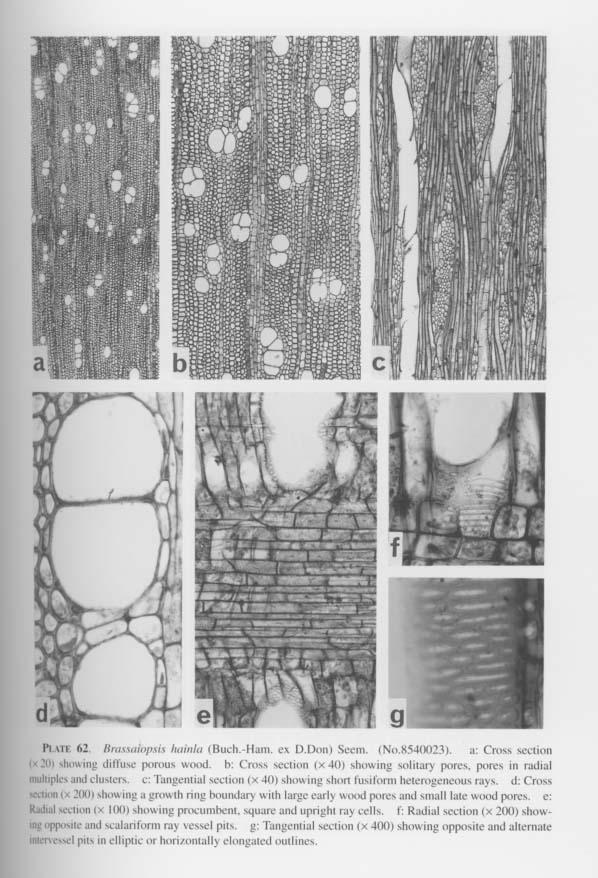
Trees in the lower temperate zone.
SPECIMENS. No. 8340036, d=- cm, alt. 1070 m: Gandaki Zone, Kaski Distr., Pokhara (950m) -Suiket (1230m), H. Ohba et al., July 6, 1983. No. 8540023*, d=20 cm, h=9 m, alt. 1820 m: Bagmati Zone,Rasuwa Distr., Syabru (2240 m)- Lama Hotel (2480 m), M. Suzuki & S. Noshiro, May 24, 1985.
DESCRIPTION. Wood diffuse porous with moderate size pores in irregular clusters; pore size rather even throughout growth rings. Growth rings not distinct, but flattened marginal fiber tracheids define growth ring boundaries; usually wide, 0.7-7.0 mm. Pores sparse, 7-32/mm2, evenly distributed, solitary, in radial multiples or in clusters; mul-tiples or clusters consisting of two to five pores. Solitary pores round or elliptic, slightly polygonal in outline, moderate in diameter, 90-160 × 70-170µm in early wood and 55-185 × 55-135 µm in late wood, thin walled (about 2 µm).
Vessel elements medium to long, 510-1020µm; perforation plates exclusively simple. Intervessel pits on both radial and tangential walls large, dense and opposite, elliptic to horizontally elongated in outline, occasionally alternate,round or polygonal in outline, 10.0-77.5 µm in diameter, with round, elliptic or horizontally elongated apertures. Spiral thickenings absent.
Non-perforated tracheal elements fiber tracheids, rarely septate. Fiber tracheids con-stituting ground mass of wood, polygonal in cross section, 10-40µm in diameter, with thick walls (about 3µm). Bordered pits on both radial and tangential walls, rather dense especially on radial walls, small and round, about 3µm in diameter, with slitlike apertures. Spiral thickenings absent.
Wood parenchyma scanty paratracheal and sparse. Crystals absent.
Rays heterogeneous, uniseriate and multiseriate, occupying 15.0-34.0 (average 23.0) % of horizontal length in tangential section. Uniseriate rays consisting of square to upright cells, 1-8 cells and 90-570µm tall. Multiseriate rays medium to narrow and low fusiform in tangential section, mostly made up of procumbent cells with square or upright cells at the periphery, upper and lower ends of multiseriate bodies, occasionally with uniseriate wings 2-6 cells tall, 2-8 cells and 35-160µm wide, and 170-2680 µm tall. Procumbent cells round or elliptic and slightly polygonal in tangential section, 20-35, 10-30 × 70-195 µm; square or upright cells elliptic or oblong in tangential section, 55-150, 15-35 × 30-50µm. Ray vessel pits, large, opposite to scalariform, round, elliptic to horizontally elongated with elliptic or window-like apertures, 8-45µm in diameter. Crystals absent.
Brassaiopsis mitis C.B. Clarke [Plate 63]

Evergreen small trees in the temperate zone.
SPECIMENS. No. 8840186, d=10 cm, h=7 m, alt. 2200 m: Koshi Zone, Sakuwasabha Distr., Uttise Kharaka (2290 m)- Bhainsi Kharaka (2540 m), M. Suzuki et al., July 14, 1988. No. 9263051*, d=7 cm, h=8 m, alt. 2250m: Mechi Zone, Taplejung Distr., Papung (1940 m)- Dongen (2260 m) -Sewaden (2490 m), M. Suzuki et al,. May 14, 1993.
DESCRIPTION. Wood diffuse porous with small polygonal pores in irregular clus-ters; pore clusters in wavey tangential pattern; pore size reduced gradually from begin-ning to end of growth rings. Growth rings distinct by mean of pore diameter and flattened marginal fiber-tracheids defining growth ring boundaries, usually wide 0.9-4.2mm. Pores sparse, 16-64/mm2, mostly in clusters, often aligned horizontally to obliquely, or in radial multiples, occasionally solitary; clusters or multiples consisting of two to ten or more pores. Pores polygonal in outline, small, 55-140× 40-90 µm in early wood and 45-90 × 30-70µm in late wood, thin-walled (about 2 µm).
Vessel elements medium in length, 440-870 µm; perforation plates mostly simple,
occasionally scalariform with a few bars. Intervessel pits on both radial and tangential walls, dense and alternate, round and polygonal or elliptic, occasionally horizontally elongated, 7-30µm in diameter, with elliptic to horizontally elongated apertures. Spiral thickenings absent.
Non-perforated tracheal elements fiber tracheids, rarely septate. Fiber tracheids con-stituting ground mass of wood, polygonal in cross section, 10-35 µm in diameter, thin-walled (about 2µm). Bordered pits on both radial and tangential walls, sparse to mod-erately spaced, small and round, about 2 µm in diameter, with slit-like apertures. Spiral thickenings absent.
Wood parenchyma scanty paratracheal and sparse. Crystals absent.
Rays heterogeneous, uniseriate and multiseriate, occupying 18.0-30.0 (average 24.0) % of horizontal length in tangential section. Uniseriate rays consisting of square to upright cells, 1-16 cells and 60-570 µm tall (No. 8840186), or 1-39 cells and 70-2860µm or more tall (No. 9263051). Multiseriate rays wide fusiform in tangential section, made up of procumbent, square and upright cells, occasionally with uniseriate wings (No. 8840186), or narrow and very tall in tangential section, mostly made up of square and upright cells (No. 9263051); square and upright cells arranged at periphery of multiseriate bodies like sheath cells; 2-8 cells and 45-170 wide, 200-1990 µm tall with uniseriate wings 2-6 cells tall (No. 8840186), or 2-5 cells and 30-100µm wide, 630-10400 µm or more tall, often exceeding the vertical length of tangential section (No. 9263051). Procumbent cells round to elliptic in tangential section, 20-45, 7-35 × 55-120 µm; square or upright cells elliptic to oblong in tangential section, 40-150, 15-40 × 20-65 µm. Ray vessel pits moderately spaced and opposite to scalariform, rounded to horizontally elongated with elliptic or window-like apertures, 8-30 µm in diameter.Crystals absent.
Gamblea ciliata C.B. Clarke [Plate 64]
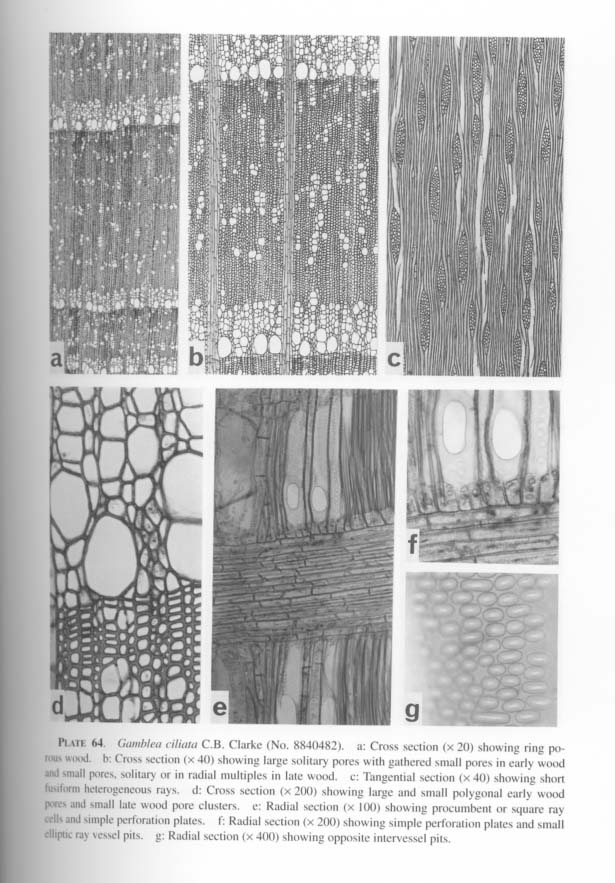
Deciduous small trees in the upper temperate and subalpine zones.
SPECIMENS. No. 8340158, d=25 cm, h=7 m, alt. 3060 m: Dhawalagiri Zone, Myagdi Distr., Deolari (3050 m)- Ghodepani Deorali (2830 m), H. Ohba et al., July 12, 1983. No. 8340470, d=25 cm, h=7 m, alt. 2840 m: Janakpur Zone, Dolakha Distr., Kyalche (2700m)- Thandingma (3200m), H. Ohba et al., Sept. 1, 1983. No. 9154098, d=60 cm, h=10 m, alt. 2980 m: Koshi Zone, Sankhuwa Sabha Distr., Angare Kharka (2930m)- Chhippon (Chhippon Pokhari) (2980m), H. Ohba et al., July 18, 1991. No. 9263208, d=18 cm, h=9 m, alt. 2960m: Mechi Zone, Taplejung Distr., Chairam (3720 m)-Andha Phedi (3420 m)- Dorongden (2890 m), S. Noshiro et al., June 11, 1993. No. 8840198, d=30 cm, h=15 m, alt. 2430 m: Koshi Zone, Sakuwasabha Distr., Uttise Kharaka (2290 m)- Bhainsi Kharaka (2540 m), M. Suzuki et al., July 14, 1988. No. 8840482*, d=20cm, h=5.5 m, alt. 3060m: Gandaki Zone, Kaski Distr., Banthanti (2600 m)- Ghodepani Deurali (3050 m), M. Suzuki et al., Aug. 24, 1988.
DESCRIPTION. Wood ring porous with pore zone of one row of large polygonal solitary pores and numerous small pores at beginning of growth rings and small soli-tary pores, and in radial multiples in late wood; pore size reduced gradually from early to late wood except at beginning of growth rings. Growth rings distinct, usually nar-row, 0.3-2.2 mm. Pores 96-147/mm2 in late wood, solitary or in radial multiples of two to ten or more in late wood; solitary round to elliptic or polygonal in outline, medium to small in early wood, 45-150 × 30-120µm, small in late wood, 25-55 × 20-45 µm, with thin-walled (about 2 µm).
Vessel elements medium in length, 410-760µm; perforation plates mostly simple and occasionally scalariform with two to eight bars. Intervessel pits on both radial and tangential walls rather dense and mainly opposite, occasionally alternate, round or el-liptic, occasionally horizontally elongated, 10-33µm in diameter, with elliptic aper-tures. Spiral thickenings absent.
Non-perforated tracheal elements fiber tracheids, septate fiber tracheids absent. Fi-ber tracheids constituting ground mass of wood, round or polygonal in cross section, 7-25 µm in diameter, thin-walled (about 2µm). Bordered pits moderately spaced on radial walls and sparse on tangential walls, round and small, about 3 µm in diameter, with slit-like apertures. Pine spiral thickenings present.
Wood parenchyma scanty paratracheal in early wood and very rare in late wood. Crystals absent.
Rays heterogeneous, uniseriate and multiseriate, occupying 14.0-19.0 (average 16.0) % of horizontal length in tangential section. Uniseriate rays consisting of proc-umbent and square or upright cells, 1-7 cells and 25-240 µm tall. Multiseriate rays small and low fusiform in tangential section, mostly made up of procumbent cells with square or upright cells at upper and lower ends of multiseriate bodies, 2-5 cells and 20-75 µm wide, and 90-610µm tall. Procumbent cells round to elliptic and slightly polygonal in tangential section, 15-28, 8-22 × 25-205 µm; square or upright cells elliptic or oblong in tangential section, 40-75, 15-30× 20-55µm. Ray vessel pits moderately spaced and opposite or alternate, round or elliptic with elliptic apertures, 7-27 µm in diameter. Crystals absent.
Hedera nepalensis K. Koch [Plate 65]
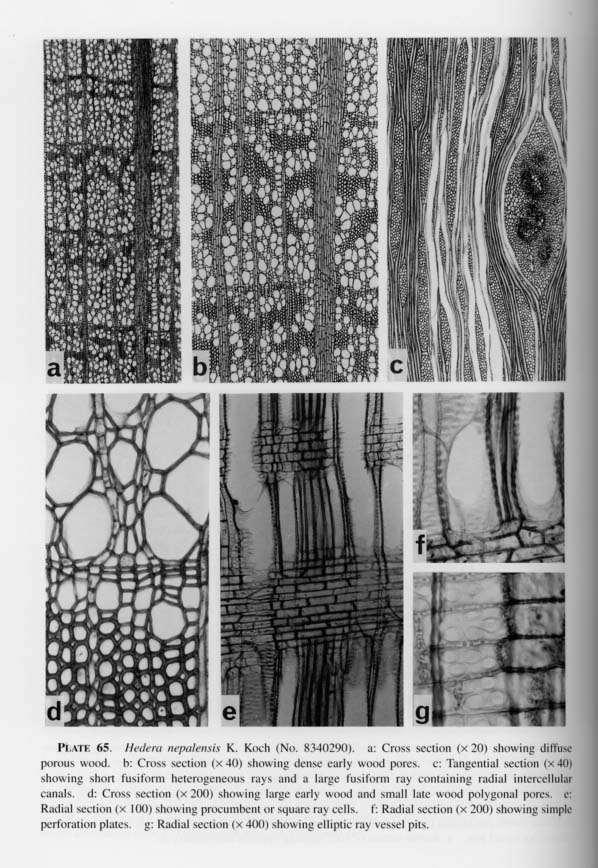
Evergreen vines in the temperate zone.
SPECIMENS. No. 9104438, d=6 cm, alt. 2750 m: Karnali Zone, Dolpa Distr., Rachi (2990 m)- teahouse (3060 m) -Chepka (2710 m) -Ankhe (2680 m), M. Minaki et al., Oct. 9, 1991. No. 8340290*, d=10 cm, alt, 2850 m: Gandaki Zone, Manang Distr., Bardang (2850m)- Chame (2630m), H. Ohba et al., Aug. 5, 1983. No. 8840581, d=24 cm, alt. 2320 m; Dhawaragiri Zone, Mustang Distr., Tukuche (2580 m)-Tallo Ghansa (1980 m), M. Suzuki et al., Sept. 2, 1988.
DESCRIPTION. Wood diffuse porous with numerous small polygonal pores in irregular clusters; pore size reduced slightly toward growth ring boundaries, and diminished at end of the growth rings. Growth rings distinct, by mean of pore diameter and flattened marginal fiber tracheids, usually narrow, 0.1-1.9 mm. Pores abundant, 112-176/mm2, solitary or in clusters with two to four pores, dense and evenly distributed in early wood, in irregular clusters with two to four pores which arranged horizontally or ob-liquely in late wood; pores 40-120 × 35-100 µm in early wood and 30-80 × 25-80µm in late wood, thin-walled (about 2 µm).
Vessel elements medium in length, 480-610 µm; perforation plates exclusively simple. Intervessel pits on both radial and tangential walls, dense and mainly opposite, occa-sionally alternate especially on the walls of thin vessel elements, round or horizontally
elliptic in outline, 10-20µm in diameter, with slit-like, round or elliptic apertures. Spiral thickenings absent.
Non-perforated tracheal elements fiber tracheids. Fiber tracheids constituting ground mass of wood, polygonal in cross section, 8-25 µm in diameter, with thick walls (about 3µm).Bordered pits on both radial and tangential walls, dense on radial walls and moderately spaced on the tangential walls, small and round, about 3 µm in diameter, with slit-like apertures. Spiral thickenings absent.
Wood parenchyma scanty paratracheal and rare. Crystals absent.
Rays heterogeneous, uniseriate and multiseriate, occupying 23.0-28.0 (average 24.8) % of horizontal length in tangential section. Uniseriate rays consisting of square to procumbent cells, 1-12 cells and 20-280 µm tall. Multiseriate rays medium in width and moderately tall fusiform, occasionally very large containing radial intercellular canals; mainly consisting of procumbent to square cells, with square to upright cells at the upper and lower ends of multiseriate bodies, 2-9 cells and 30-130µm wide, 80-2250 µm tall. Procumbent cells round in tangential section, 13-35, 8-20 × 60-155 µm; square or upright cells elliptic or occasionally oblong in tangential section, 35-55, 13-28 × 30-40 µm. Ray vessel pits large and moderately spaced, elliptic or horizontally elongated, with round or window-like apertures, 10-23 µm in diameter. Crystals ab-sent.
Pentapanax leschenaultii (DC.) Seem. [Plate 66]
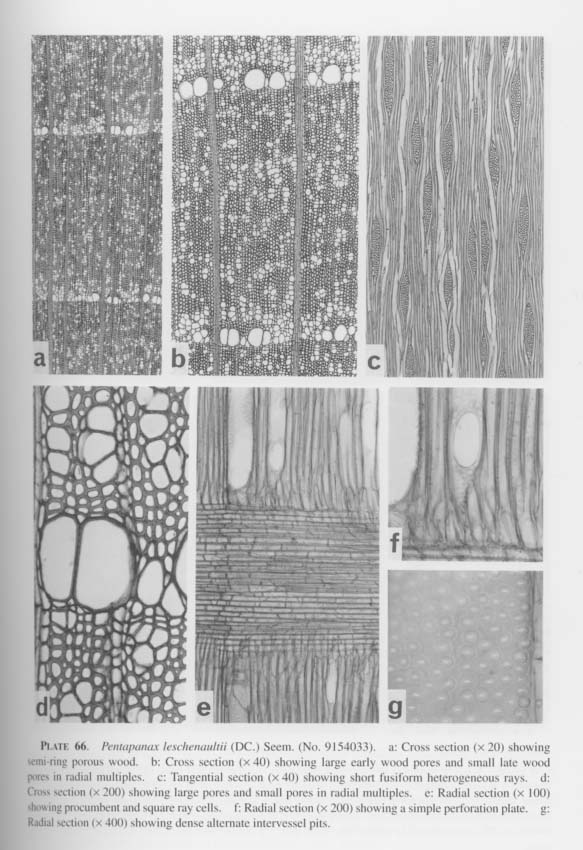
Epiphytic deciduous shrubs in the temperate and subalpine zones.
SPECIMENS. No. 8340023, d=- cm, alt. 2650 m: Bagmati Zone, Kathmandu Val-ley, Mt. Pulchoke, H. Ohba et al., June 30, 1983. No. 8540034, d=20 cm, h=6 m, alt. 2470 m: Bagmati Zone, Rasuwa Distr., Syabru (2240 m) - Lama Hotel (2480 m), M. Suzuki & S. Noshiro, May 24, 1985. No. 8540155, d=6 cm, h=3 m, alt. 3100 m: Janakpur Zone, Ramechap Distr., Deorali (2700 m)- Serdingma (3400 m), H. Ohba et al., July 6, 1985. No. 9263136, d=44cm, h=4 m, alt. 2080m: Mechi Zone, Taplejung Distr., Thakpa Bazaar (1600m)- Suketar (Tamur bridge) (2020m)- Ramsyang Pati (2310 m), M. Suzuki et al., May 23, 1993. No. 9154033*, d=8 cm, h=1.2 m, alt. 2530 m: Koshi Zone, Khankuta Distr., Tute (2340 m) -Tinjure Phedi (2660 m), H. Ohba et al., July 14,1991.
DESCRIPTION. Wood semi-ring porous with moderate to small pores in a tangential row at beginning of growth rings and radially multipled or solitary small pores in late wood; pore size reduced gradually from beginning to end of growth rings. Growth rings distinct, by mean of pore size and flattened marginal fiber tracheids, usually wide, 0.7-4.3 mm. Pores abundant, 83-160/mm2, solitary, in radial multiples or in clus-ters except at beginning of growth rings, multiples or clusters consisting of two to about ten pores; elliptic or polygonal in outline, medium in size, 45-150 × 35-130 µm at beginning of growth rings, and small, 30-65 × 25-45µm in late wood, thin-walled (about 2 µm).
Vessel elements medium in length, 350-580 µm; perforation plates exclusively simple. Intervessel pits on both radial and tangential walls, moderately spaced and slightly alternate, round or slightly polygonal in outline, about 10µm in diameter, with roundor elliptic apertures. Spiral thickenings absent.
Non-perforated tracheal elements fiber tracheids, sometimes septate. Fiber tracheids constituting ground mass of wood, polygonal in cross section, 7-22 µm in diameter, with thick-walls (about 3µm). Bordered pits on both radial and tangential walls, small and round, about 3µm in diameter, with slit-like apertures. Spiral thickenings absent.
Wood parenchyma scanty paratracheal and rare. Crystals absent.
Rays heterogeneous, uniseriate and multiseriate, occupying 7.0-15.0 (average 12.0) % of horizontal length in tangential section. Uniseriate rays consisting of square to proc-umbent cells, 1-10 cells and 25-240 µm tall. Multiseriate rays narrow and low fusi-form in tangential section, mostly made up of procumbent cells with square or upright cells at the periphery, upper and lower ends of multiseriate bodies, 2-6 cells and 20-80 µm wide, 110-650µm tall. Procumbent cells round or slightly polygonal in tangen-tial section, 15-23, 5-20 × 55-180µm; square or upright cells elliptic or oblong in tangential section, 35-75, 10-20 × 15-45µm. Ray vessel pits large and moderately spaced, opposite to alternate, round or elliptic with elliptic or window-like apertures, 7-10µm in diameter. Crystals absent.
Pentapanax racemosus Seem. [Plate 67]
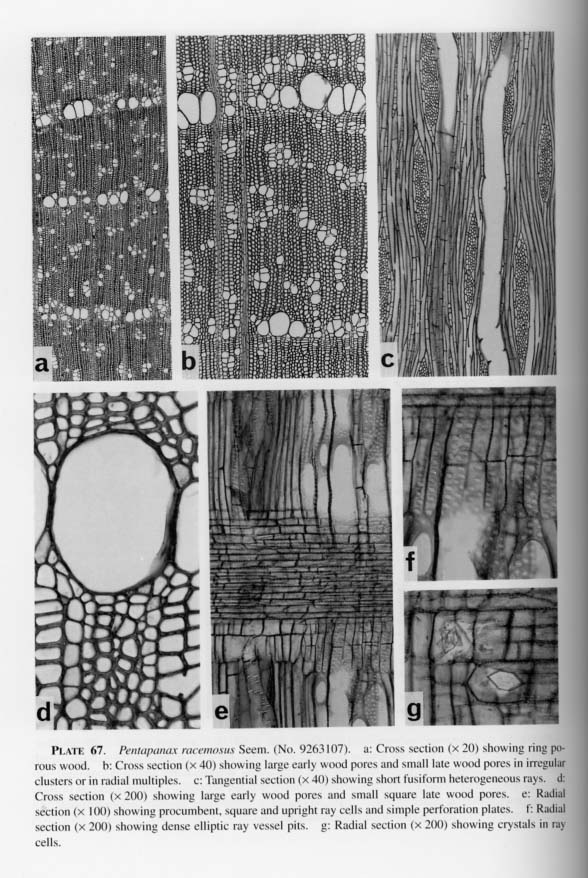
Epiphytic deciduous shrubs in the upper temperate zone.
SPECIMENS. No. 8840128, d=3.5 cm, alt. 1990 m: Koshi Zone, Sakuwasabha Distr., Sakrate (1840 m) -Hurhure (2040 m)-Mude (2040 m), M. Suzuki et al., July 9, 1988. No. 9154028, d=4 cm, h=2 m, alt. 2300 m: Koshi Zone, Khankuta Distr., Shidua (2140 m)-Tute (2340 m), H. Ohba et al., July 13, 1991. No. 9263107*, d=12cm, h=3 m, alt. 2350 m: Mechi Zone, Taplejung Distr., Syamba (1610 m)-Manabhara (deurali 1) (2570 m)-Manabhara (deurali2) (2600 m) -Bhirkuna (1980 m), M. Suzuki et al., May 20, 1993. No. 9263214, d=2 cm, h=2 m, alt. 2310 m: Mechi Zone, Taplejung Distr., Dorongden (2890 m)- Deurali (3310 m) -Amji Khola (2320 m), S. Noshiro et al., June 12, 1993.
DESCRIPTION. Wood ring porous with a single row of large pores at beginning of growth rings, and sparsely distributed small pore clusters in late wood; reduction in pore size from early- to late wood usually abrupt. Growth rings distinct, ring porosity and flattened marginal fiber tracheids defining growth ring boundaries; usually wide, 1.1-4.2 mm. Pores at pore zone solitary, in radial multiples or in irregular clusters with several pores; pores in late wood moderately spaced, 56-76/mm2, solitary, in radial multiples or in irregular clusters with consisting of 2-7(-10) pores. Solitary pores round and slightly polygonal, small to medium, 50-210 × 50-195µm in pore zone, and 30-70 × 25-55 µm in late wood, thin-walled (about 2 µm).
Vessel elements medium in length, 350-890 µm; perforation plates exclusively simple. Intervessel pits on both radial and tangential walls, rather dense and alternate, round or elliptic and slightly polygonal, 8-13 µm in diameter, with elliptic apertures. Spiral thick-enings absent.
Non-perforated tracheal elements fiber tracheids, sometimes septate. Fiber tracheids constituting ground mass of wood, polygonal in cross section, 7-35 µm in diameter, with thick walls (about 3 µm). Bordered pits on both radial and tangential walls, mod-erately spaced, small and round, about 3 µm in diameter, with slit-like apertures. Fine spiral thickenings sometimes present on inner walls of fiber tracheids.
Wood parenchyma scanty paratracheal and very rare. Crystals absent.
Rays heterogeneous, uniseriate and multiseriate, occupying 9.0-16.0 (average 13.2) % of horizontal length in tangential section. Uniseriate rays consisting of square or upright to procumbent cells, 1-7 cells and 50-450 µm tall. Multiseriate rays medium in width and low fusiform in tangential section, mostly made up of procumbent cells with square or upright cells at the periphery, upper and lower ends of multiseriate bodies, 2- 7 cells and 20-110µm wide, and 130-1780 µm tall. Procumbent cells round or slightly polygonal in tangential section, 15-25, 8-18 × 38-175 µm; square or upright cells elliptic to vertically elongated in tangential section, 28-100, 18-25 × 20-33µm. Ray vessel pits moderately spaced and opposite, round or elliptic with large elliptic or window-like apertures, 7-13 µm in diameter. Crystals present in the square or upright cells.
Schefflera impressa (C.B. Clarke) Harms [Plate 68]
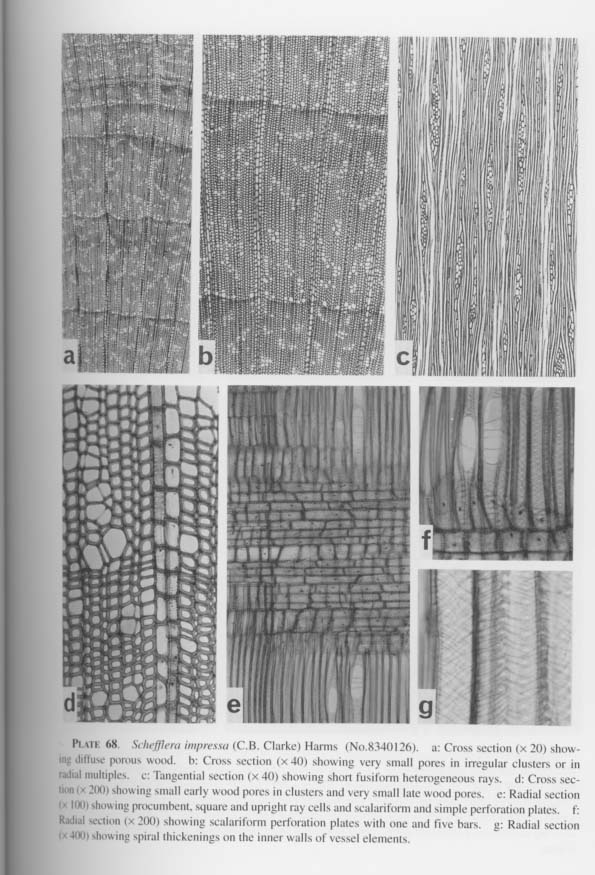
Evergreen small trees in the upper temperate zone.
SPECIMEN. No. 8340126*, d=5 cm, h=3 m, alt. 2480 m: Gandaki Zone, Kaski Distr., Bhainsi Kharaka (2460 m)-Banthanti (2600 m), H. Ohba et al., July 11, 1983.
DESCRIPTION. Wood diffuse porous with numerous very small polygonal pores; pore size reduced gradually from beginning to end of growth rings. Growth rings distinct, by mean of flattened marginal fiber tracheids, usually narrow, 0.3-1.2 mm. Pores abundant, 200-298/mm2, evenly distributed throughout growth rings, in radial to horizontal multiples or in irregular clusters, occasionally solitary; multiples or clusters consisting of two to about ten or more pores. Solitary pores slightly polygonal in outline, very small, 18-35 × 22-45 µm in early wood and 15-25 × 15-25µm in late wood, thin-walled (about 2 µm).
Vessel elements long, 720-930µm; perforation plates simple or scalariform with three to eleven bars. Intervessel pits on both radial and tangential walls, moderately spaced and opposite, round, 7-10µm in diameter, with round and tiny apertures. Spiral thickenings present on entire inner walls.
Non-perforated tracheal elements fiber tracheids, few septate. Fiber tracheids constituting ground mass of wood, polygonal in cross section, 10-25µm in diameter, thin-walled (about 25 µm). Bordered pits on both radial and tangential walls, dense, small and round, about 2 µm in diameter, with slit-like apertures. Spiral thickenings absent.
Wood parenchyma scanty paratracheal and very rare. Crystals absent.
Rays heterogeneous, uniseriate and multiseriate, occupying 15.0-22.0 (average 17.2) % of horizontal length in tangential section. Uniseriate rays consisting of square to procumbent and upright cells, 1-13 cells and 80-1090 µm tall. Multiseriate rays moderate to narrow and low fusiform in tangential section, made up of procumbent cells with square to upright cells on the periphery, upper and lower ends of multiseriate bodies, often with uniseriate wings 2-10 cells and up to 610 µm tall, 2-7 cells and 30-90 µm wide, 200-123 µm tall. Procumbent cells round or slightly polygonal in tangential section, 25-45, 8-23 × 42-135µm, square or upright cells elliptic to vertically elongated in tangential section, 60-110, 15-30 × 25-50 µm. Ray vessel pits moderately spaced and opposite, round or slightly elliptic with round, large elliptic or window-like apertures, 7-13 µm in diameter. Crystals absent.
ERICACEAE (Shuichi NOSHIRO)
Rhododendron cameliiflorum Hook. f. [Plate 69]
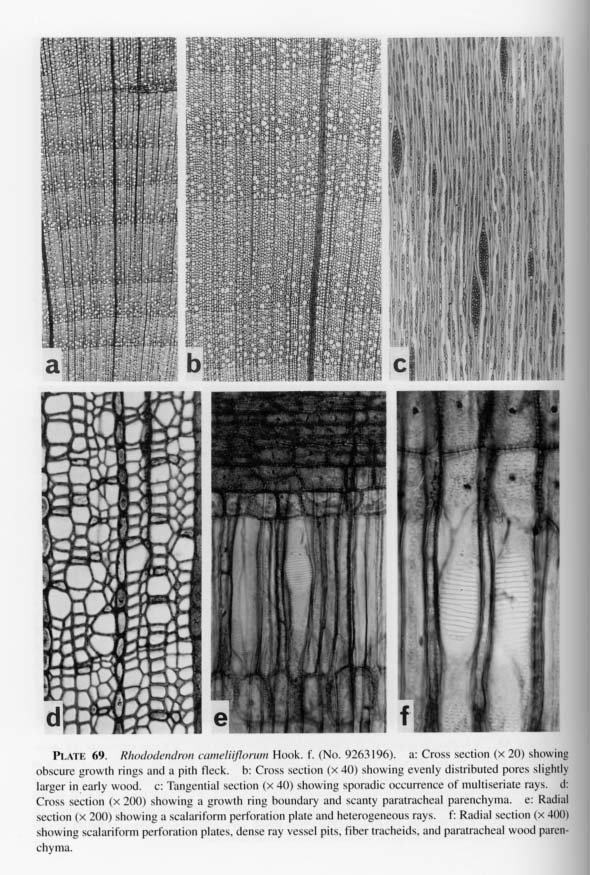
Evergreen shrubs in the subalpine zone.
SPECIMENS. No. 9154099, d=4 cm, h=0.6 m, alt. 3020 m: Koshi Zone, Sankuwasabha Distr., Chhippon (Chhippon Pokhari) (2980 m)-Gidde (Gidde Kharka) (3500 m), H. Ohba et al., July 19, 1991. No. 9263090, d=5 cm, h=1.8 m, alt. 2990 m: Mechi Zone, Taplejung Distr., Topke Gola (3590 m)-Sewaden (2490 m), M. Suzuki et al., May 17, 1993. No. 9263196*, d=4 cm, h=1.8 m, alt. 2700 m: Mechi Zone, Taplejung Distr., Gyabia (2630 m)-Nag Pokhari Khola (2620 m) - Fale (3140 m)-Ghunsa (3300 m), S. Noshiro et al., June 6, 1993.
DESCRIPTION. Wood diffuse porous with very small pores and occasional pith flecks. Growth rings present, usually defined by larger early wood pores, thicker early wood, and terminal flattened fiber tracheids; false growth rings occasionally formed; growth rings fairly narrow, 0.15-1.4 mm.
Pores evenly distributed with a tendency to be larger and more in the early wood, 330-520/mm2; mostly solitary, or in tangential to oblique (occasionally radial) multiples or clusters of 2 or 3; pores polygonal or square in outline, (8-) 17-31 (-39) and (8-)15-26(-40)µm in radial and tangential diameters respectively, very thin-walled (less than 1 µm thick).
Vessel elements fairly short (300-500µm); perforation plates small and exclusively scalariform, sometimes becoming partly reticulate; bars mostly 13-22, usually thicker in late wood vessels. Intervessel pits opposite, partly scalariform, round or horizontally oblong in outline (about 3-12 µm in horizontal diameter), with slit-like apertures. Spiral thickenings restricted to ligulate ends of vessel elements.
Non-perforated tracheal elements fiber tracheids. Fiber tracheids constituting ground mass of wood, fairly small rectangular or polygonal in outline, 10-22 and 8-22µm in radial and tangential diameters respectively, usually one layer of fiber tracheids becoming flattened (4-8 µm in radial diameter) at termination of growth rings; walls fairly thin (less than 2 µm), slightly thicker in early wood than in late wood; bordered pits sparse and very small (about 4µm in diameter), with slit-like oblique apertures; spiral thickenings absent.
Wood parenchyma scanty paratracheal, 1-2 cells mostly on outer margin of vessels, and sometimes at initiation of growth rings; quite difficult to recognize in cross section because of great similarity in size to fiber tracheids, very thin-walled (less than 1 µm) with sparse small simple pits on radial and tangential walls and dense ones on horizontal walls; crystals absent.
Rays heterogeneous, uniseriate and multiseriate. Uniseriate rays tall and consisting wholly of upright cells with rare square cells, mostly 1-11 cells and 25-630 µm, sometimes taller. Multiseriate rays scattered sporadically among uniseriate rays, 2.2-2.4/mm2 (No. 9263196), or evenly, 4.1-11.8/mm2 (Nos. 9154099 and 9263090); 2-7 cells and 15-70µm wide, and 110-810µm tall, made up of a multiseriate central core of procumbent cells and low uniseriate wings of square and upright cells; uniseriate wings usually with 1-8 cells. Upright and square cells more or less slender elliptic or oblong in tangential section, 40-90, 10-18 and 15-60µm in vertical, tangential and radial diameters respectively. Procumbent cells oval or polygonal in tangential section, 10
35, 10-20 and 30-80 µm in vertical, tangential and radial diameters respectively. Crystals absent in ray cells. Ray vessel pits numerous and loosely alternate or opposite, occasionally in irregular vertical files, round, or slightly elongated horizontally with horizontal slit-like apertures and narrow borders, about 3-8 µm in horizontal diameter.
Rhododendron campylocarpum Hook. f. [Plate 70]
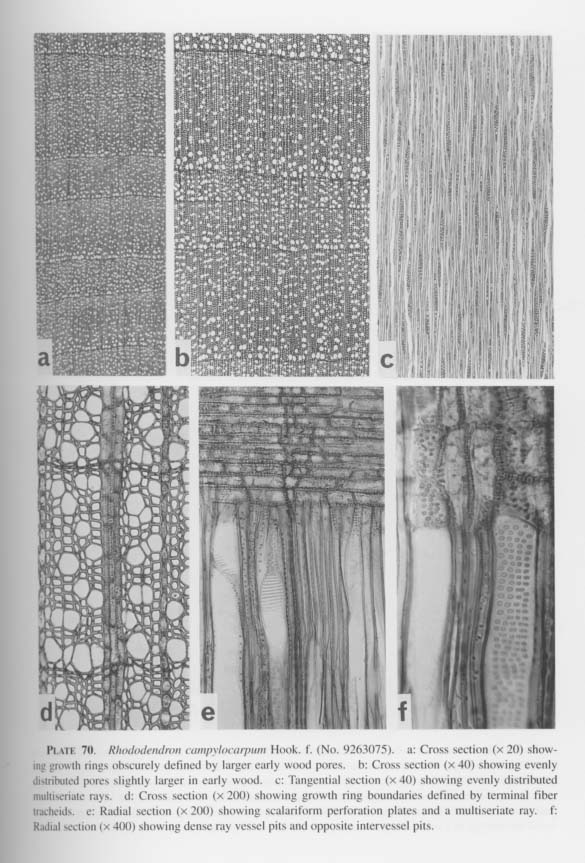
Evergreen shrubs in the subalpine and lower alpine zones.
SPECIMENS. No. 8840265, d=5 cm, h=1.3 m, alt. 3780 m: Koshi Zone, Sakuwasabha Distr., Tutu La (4070m) -Numbuk (3500m), M. Suzuki et al., July 17, 1988. No. 8840275, d=6 cm, h=1.8 m, alt. 3800 m: Koshi Zone, Sakuwasabha Distr., Tutu La (4070 m) -Numbuk (3500 m), M. Suzuki et al., July 17, 1988. No. 8840336, d=6 cm, h=1.5m, alt. 3760m: Koshi Zone, Sankuwasabha Distr., Ta Dasa (3900m) - Phemathang Kharka (3380 m), M. Suzuki et al., July 28, 1988. No. 8840345, d=5 cm, h=1.2m, alt. 3450m: Koshi Zone, Sankuwasabha Distr., Ta Dasa (3900m) - Phemathang Kharka (3380 m), M. Suzuki et al., July 28, 1988. No. 8840351, d=8 cm, h=1.3 m, alt. 3220 m: Koshi Zone, Sankuwasabha Distr., Phemathang Kharka (3380 m) -Cha Ding Kharka (3970 m), M. Suzuki et al., July 29, 1988. No. 9154105, d=11 cm, h=2 m, alt. 3340 m: Koshi Zone, Sankuwasabha Distr., Chhippon (Chhippon Pokhari) (2980m) -Gidde (Gidde Kharka) (3500m), H. Ohba et al., July 19, 1991. No. 9154135, d=6cm, h=1.6m, alt. 3640m: Koshi Zone, Sankuwasabha Distr., SW ridge of Tin Pokhari (4020-3650 m), H. Ohba et al., July 31, 1991. No. 9263075*, d=8 cm, h=5.5 m, alt. 3020 m: Mechi Zone, Taplejung Distr., Sewaden (2490 m) -a bridge (2760 m) -a kharka (3120 m) -Topke Gola (3590 m), M. Suzuki et al.. May 15, 1993. No. 9263159, d=8 cm, h=4.5 m, alt. 3200 m: Mechi Zone, Taplejung Distr., Deuma Kharka (3855 m) - flow junction (3575 m) - Wolangchung Gola (3110 m). M. Suzuki et al., May 28, 1993.
DESCRIPTION. Wood diffuse porous with very small pores and occasional pith flecks. Growth rings present, usually defined by larger early wood pores and terminal flattened fiber tracheids; false growth rings occasionally formed; growth rings fairly narrow, 0.2-1 mm or less.
Pores evenly distributed, 350-485/mm2, gradually reduced in size toward growth ring boundaries; larger pores usually making an almost continuous row at beginning of growth rings, with a tendency toward weak semi-ring-porosity, mostly solitary, or in tangential to oblique (occasionally radial) multiples or clusters of 2-3; pores polygonal or square in outline, (6-)12-36(-49) and (6-) 15-27(-45) µm in radial and tangential diameters respectively, very thin-walled (less than 1 µm thick).
Vessel elements fairly short (250-400 µm); perforation plates small and exclusively scalariform, sometimes becoming partly reticulate; bars mostly 10-20, and usually thicker in late wood vessels. Intervessel pits loosely opposite, occasionally in vertical files, round or horizontally oblong in outline (about 4-10 µm in horizontal diameter), with slit-like apertures. Thin spiral thickenings present throughout vessel elements.
Non-perforated tracheal elements fiber tracheids. Fiber tracheids constituting ground mass of wood, fairly small rectangular or polygonal in outline, 5-22 and 5-25 µm in radial and tangential diameters respectively, usually 1-2 layers of fiber tracheids becoming flattened (3-8 µm in radial diameter) at termination of growth rings; walls fairly thin (less than 2 µm), and in some individuals, slightly thicker in early wood than in late wood; bordered pits sparse and very small (about 4µm in diameter), with slit-like oblique apertures; spiral thickenings absent.
Wood parenchyma scanty paratracheal, 1 or 2 cells usually on outer margin of vessels, sometimes at initiation of growth rings; quite difficult to recognize in cross section because of great similarity to fiber tracheids, thin-walled (about 1.5 µm) with sparse small simple pits on radial and tangential walls, and dense ones on horizontal walls; crystals absent.
Rays heterogeneous, uniseriate and multiseriate. Uniseriate rays tall and consisting mostly of upright cells with occasional square cells, mostly 1-7 cells and 25-350µm. Multiseriate rays evenly scattered among uniseriate rays, 9.7-16.2/mm2; 2-3 cells and 12-56µm wide, and 105-596 µm tall, made up of a multiseriate central core of procumbent cells and low uniseriate wings of square and upright cells; uniseriate wings usually with 1-9 cells. Upright and square cells more or less slender elliptic or oblong in tangential section, 18-75, 8-20 and 12-45 µm in vertical, tangential and radial diameters respectively. Procumbent cells oval or polygonal in tangential section, 10-25, 8-22 and 22-110µm in vertical, tangential and radial diameters respectively. Crystals absent in ray cells. Ray vessel pits numerous, loosely alternate or opposite, occasionally in irregular vertical files, round, or slightly elongated horizontally with horizontal slit-like apertures and narrow borders, about 3-8 µm in diameter.
Rhododendron cinnabarinum Hook. f. [Plate 71]
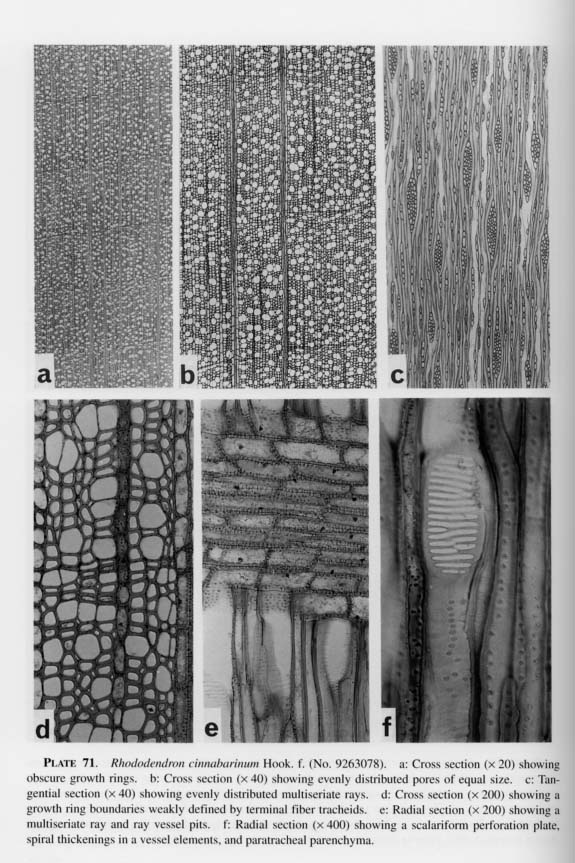
Evergreen large shrubs in the subalpine and lower alpine zones.
SPECIMENS. No. 8840246, d=12 cm, h=3 m, alt. 3370 m: Koshi Zone, Sakuwasabha Distr., Danda Kharka (2860 m) -Unshisa Kharka (3150 m) - Khongma (3500 m), M. Suzuki et al., July 15, 1988. No. 8840247, d=12cm, h=3 m, alt. 3500m: Koshi Zone, Sakuwasabha Distr., around Khongma (3500 m), M. Suzuki et al., July 16, 1988. No. 8840264, d=4 cm, h=1.8 m, alt. 3745 m: Koshi Zone, Sakuwasabha Distr., Tutu La (4070 m) - Numbuk (3500 m), M. Suzuki et al., July 17, 1988. No. 8840347, d=7 cm, h=1.3m, alt. 3440m: Koshi Zone, Sankuwasabha Distr., Ta Dasa (3900m) - Phemathang Kharka (3380 m), M. Suzuki et al., July 28, 1988. No. 8840352, d=6 cm, h=1.4 m, alt. 3220 m: Koshi Zone, Sankuwasabha Distr., Phemathang Kharka (3380 m)-Cha Ding Kharka (3970 m), M. Suzuki et al., July 29, 1988. No. 8840365, d=4.5 cm, h=1.3 m, alt. 3860 m: Koshi Zone, Sankuwasabha Distr., Cha Ding Kharka (3970m)-Shipton Pass (4120m)-Khongma (3500m), M. Suzuki et al., July 30, 1988. No. 9154102, d=10cm, h=3.5 m, alt. 3220m: Koshi Zone, Sankuwasabha Distr., Chhippon (Chhippon Pokhari) (2980 m)-Gidde (Gidde Kharka) (3500 m), H. Ohba et al., July 19, 1991. No. 9154131, d=5 cm, h=2.2 m, alt. 3770m: Koshi Zone, Sankuwasabha Distr., SW ridge of Tin Pokhari (4020-3650 m), H. Ohba et al., July 31, 1991. No. 9154206, d=13 cm, h=2.5 m, alt. 3470 m: Koshi Zone, Sankuwasabha Distr., Singoa Kharka (4140m)-Pahakhola (2400m), H. Ohba et al., Aug. 11, 1991. No. 9263078*, d=14cm, h=4m, alt. 3130m: Mechi Zone, Taplejung Distr., Sewaden (2490 m)-a bridge (2760 m)-a kharka (3120 m)-Topke Gola (3590 m), M.
Suzuki et al., May 15, 1993. No. 9263146, d=3 cm, h=2.5 m, alt. 3220 m: Mechi Zone, Taplejung Distr., around Wolangchung Gola (3110 m), M. Suzuki et al., May 25, 1993.
DESCRIPTION. Wood diffuse porous with very small pores of equal size and occasional pith flecks. Growth rings present, weakly defined by terminal flattened fiber tracheids; false growth rings occasionally formed; growth rings narrow, 0.5-2 mm or less.
Pores evenly distributed, 226-39 1/mm2, slightly reduced in size at end of growth rings, mostly solitary, or in tangential to oblique (occasionally radial) multiples or clusters of 2 or 3; pores polygonal or square in outline, (7-)18-39(-56) and (8-) 17- 34(-63) µm in radial and tangential diameters respectively, very thin-walled (less than 1 µm thick).
Vessel elements short (300-600 µm); perforation plates small and exclusively scalariform, sometimes becoming partly reticulate; bars mostly 12-20, usually thicker in late wood vessels. Intervessel pits loosely opposite or scalariform, partly in vertical files, round or horizontally oblong in outline (about 4-12 µm in horizontal diameter), with slit-like apertures. Thin spiral thickenings present throughout vessel elements.
Non-perforated tracheal elements fiber tracheids. Fiber tracheids constituting ground mass of wood, fairly small rectangular or polygonal in outline, 6-35 and 4-30 µm in radial and tangential diameters respectively, usually one layer of radially flattened fiber tracheids (4-7 µm in radial diameter) at termination of growth rings; walls thin (2.5 µm), and in some individuals slightly thicker in early wood than in late wood; bordered pits sparse and very small (about 4 µm in diameter), with slit-like oblique apertures; spiral thickenings absent.
Wood parenchyma scanty paratracheal, 1 or 2 cells usually on outer margin of vessels, or rarely diffuse; quite difficult to recognize in cross section because of great similarity of size to fiber tracheids, thin-walled (about 2 µm) with sparse small simple pits on radial and tangential walls, and dense ones on horizontal walls; crystals absent.
Rays heterogeneous, uniseriate and multiseriate, Uniseriate rays tall and consisting mostly of upright cells with occasional square cells, mostly 1-15 cells and 30-600 µm. Multiseriate rays evenly scattered among uniseriate rays, 3.5-8.1/mm2; 2-5 cells and 22-78 µm wide, and 144-1027 µm tall, made up of a multiseriate central core of procumbent cells and low uniseriate wings of square and upright cells; uniseriate wings usually with 1-5 cells. Upright and square cells more or less slender elliptic or oblong in tangential section, 60-200, 10-20 and 17-55 µm in vertical, tangential and radial diameters respectively. Procumbent cells oval or polygonal in tangential section, 12-70,12-25 and 27-140 µm in vertical, tangential and radial diameters respectively. Crystals absent in ray cells. Ray vessel pits numerous, loosely alternate or opposite, round, or slightly elongated horizontally with horizontal slit-like apertures and narrow borders, about 3-5 µm in diameter.
Rhododendron falconeri Hook. f. [Plate 72]
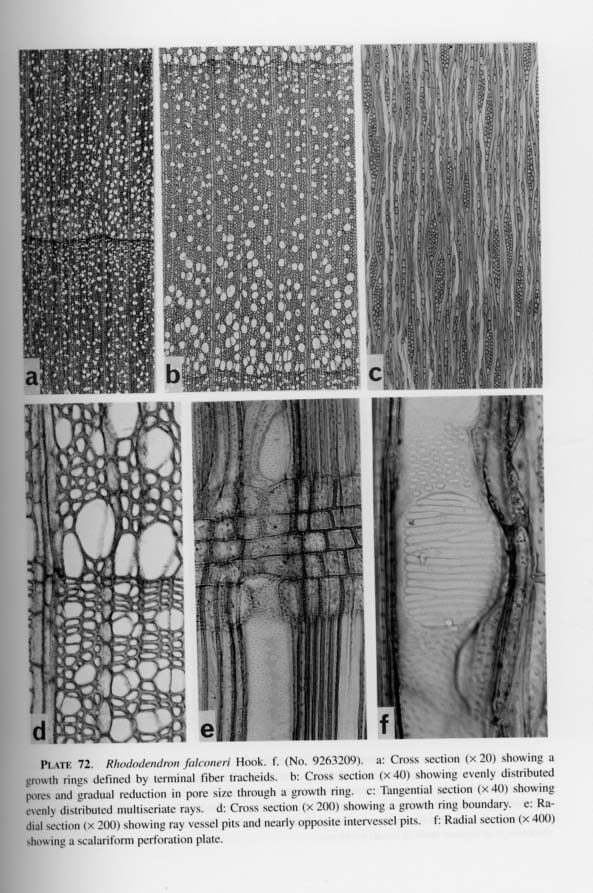
Evergreen trees in the subalpine zone.
SPECIMENS. No. 9263209*, d=42 cm, h=12 m, alt. 2900 m: Mechi Zone, Taplejung Distr., Chairam (3720 m) - Andha Phedi (3420 m) - Dorongden (2890 m), S. Noshiro et al., June 11, 1993. No. 9263227, d=25 cm, h=12m, alt. 2910m: Mechi Zone, Taplejung Distr., Sigre Danda (2200 m) - ridge (3050 m) - Bhitte Khai-ka (3410 m), S. Noshiro et al., June 15, 1993.
DESCRIPTION. Wood diffuse porous with very small pores and occasional pith flecks. Growth rings present, usually defined by larger early wood pores and terminal flattened fiber tracheids; growth rings fairly narrow, 0.2-1 mm or less.
Pores evenly distributed, 317-345/mm2, gradually reduced in size toward growth ring boundaries; larger pores often gathered and occupying a major area in early wood; mostly solitary, or in tangential to radial multiples or clusters of 2-3(-7); pores polygonal or square in outline, (10-)20-49(-65) and (10-)17-37(-54) µm in radial and tangential diameters respectively, very thin-walled (less than 1 µm. thick).
Vessel elements short (420-700 µm); perforation plates small and exclusively scalariform, sometimes becoming partly reticulate; bars mostly 12-32, usually thicker in late wood vessels. Intervessel pits loosely opposite, occasionally in vertical files, round or horizontally oblong in outline (about 4-8 µm in horizontal diameter), with slit-like apertures. Thin spiral thickenings present throughout vessel elements.
Non-perforated tracheal elements fiber tracheids. Fiber tracheids constituting ground mass of wood, fairly small rectangular or polygonal in outline, 5-35 and 5-35 µm in radial and tangential diameters respectively, usually 1 or 2 layers of fiber tracheids becoming flattened (about 5 µm in radial diameter) at termination of growth rings;walls thin (about 2.5 µm); bordered pits sparse and very small (about 4 µm in diameter), with slit-like oblique apertures; spiral thickenings absent.
Wood parenchyma scanty paratracheal, 1 or 2 cells usually on outer margin of vessels, or rarely diffuse, sometimes at initiation of growth rings, quite difficult to recognize in cross section because of great similarity in size to fiber tracheids; thin-walled (about 1.5 µm) with sparse small simple pits on radial and tangential walls and dense ones on horizontal walls; crystals absent.
Rays heterogeneous, uniseriate and multiseriate. Uniseriate rays tall and consisting mostly of upright cells with occasional square cells, mostly 1-11 cells and 40-640 µm. Multiseriate rays evenly scattered among uniseriate rays, 8.9-16.2/mm2; 2-3 cells and 21-45 µm wide, and 169-732 µm tall, made up of a multiseriate central core of procumbent cells and low uniseriate wings of square and upright cells; uniseriate wings usually with 1-8 cells. Upright and square cells more or less slender elliptic or oblong in tangential section, 25-105, 10-22 and 15-55 µm in vertical, tangential and radial diameters respectively. Procumbent cells oval or polygonal in tangential section, 8-30, 8-20 and 25-125 µm in vertical, tangential and radial diameters respectively. Crystals absent in ray cells. Ray vessel pits numerous, loosely alternate, round, or slightly elongated horizontally, with horizontal slit-like apertures and narrow borders, about 3- 12 µm in diameter.
Rhododendron fulgens Hook. f.[Plate 73]
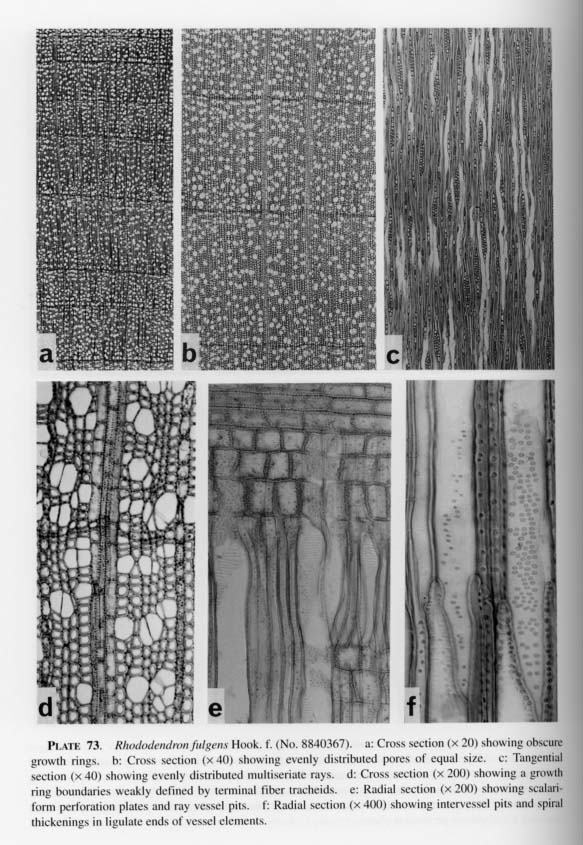
Evergreen large shrubs in the lower alpine zone.
SPECIMENS. No. 8840262, d=8 cm, h=2.5 m, alt. 3670 m: Koshi Zone, Sakuwasabha Distr., Tutu La (4070m) - Numbuk (3500m), M. Suzuki et al., July 17, 1988. No. 8840274, d=6 cm, h=3 m, alt. 3890 m: Koshi Zone, Sakuwasabha Distr., Tutu La (4070 m) - Numbuk (3500 m), M. Suzuki et al., July 17, 1988. No. 8840337, d=8 cm,
h=3 m, alt. 3760 m: Koshi Zone, Sankuwasabha Distr., Ta Dasa (3900 m) − Phemathang Kharka (3380 m), M. Suzuki et al., July 28, 1988. No. 8840350, d=3 cm, h=0.8 m, alt. 3360 m: Koshi Zone, Sankuwasabha Distr., Phemathang Kharka (3380 m) − Cha Ding Kharka (3970 m), M. Suzuki et al., July 29, 1988. No. 8840357, d=7 cm, h=1.8 m, alt. 3600 m: Koshi Zone, Sankuwasabha Distr., Phemathang Kharka (3380 m) − Cha Ding Kharka (3970 m), M. Suzuki et al., July 29, 1988. No. 8840359, d=5 cm, h=1.3 m, alt. 3970 m: Koshi Zone, Sankuwasabha Distr., Phemathang Kharka (3380 m) − Cha Ding Kharka (3970 m), M. Suzuki et al., July 29, 1988. No. 8840362, d=5 cm, h=1.3 m, alt. 4130 m: Koshi Zone, Sankuwasabha Distr., Cha Ding Kharka (3970 m) − Shipton Pass (4120 m) − Khongma (3500 m), M. Suzuki et al., July 30, 1988. No. 8840367*, d=6 cm, h=1.2 m, alt. 3500 m: Koshi Zone, Sankuwasabha Distr., Khongma (3500 m) −Tashi Gaun (2160 m), M. Suzuki et al., July 31, 1988. No. 9154128, d=8 cm, h=1.5 m, alt. 4000 m: Koshi Zone, Sankuwasabha Distr., Banduke (4150 m) − SW ridge of Tin Pokhari (4020 m), H. Ohba et al., July 30, 1991. No. 9154136, d=8 cm, h=1.5 m, alt. 3630 m: Koshi Zone, Sankuwasabha Distr., SW ridge of Tin Pokhari (4020-3650 m), H. Ohba et al., July 31, 1991. No. 9263229, d=12cm, h=2.5 m, alt. 3800m: Mechi Zone, Panchitar Distr., Thulo Bhanjyang (4050 m) − Khola Tar (3820 m) − Pademeu Kharka (3750 m) − Phedung Danda (Budipani Kharka) (3720 m), S. Noshiro et al., June 19, 1993.
DESCRIPTION. Wood diffuse porous with very small pores of equal size and occasional pith flecks. Growth rings present, defined by larger early wood pores and terminal flattened fiber tracheids; false growth rings occasionally formed in outermost part; growth rings narrow, 0.18-1.5 mm or less.
Pores evenly distributed, 285-409/mm2, slightly reduced in size at end of growth rings; larger pores usually forming an almost continuous row at beginning of growth rings, mostly solitary, or in tangential to oblique (occasionally radial) multiples or clusters of 2 or 3; pores polygonal or square in outline, (8-)15-39(-50) and (6-)15- 31(-54) µm in radial and tangential diameters respectively, very thin-walled (less than 1 µm thick).
Vessel elements short (180-400 µm); perforation plates small and exclusively scalariform with 10-17 bars, and sometimes becoming partly reticulate; in the late wood vessels, bars usually becoming thicker with narrower intervals, and tend to be more reticulate. Intervessel pits loosely opposite or scalariform, partly in vertical files, round or horizontally oblong in outline (about 4-8 µm in horizontal diameter), with slit-like apertures. Thin spiral thickenings present throughout vessel elements.
Non-perforated tracheal elements fiber tracheids. Fiber tracheids constituting ground mass of wood, fairly small rectangular or polygonal in outline, 5-30 and 5-25 µm in radial and tangential diameters respectively, usually 1-3 layers of radially flattened fiber tracheids (5 µm or less in radial diameter) at termination of growth rings; walls thin (2.5 µm), and in some individuals slightly thicker in early wood than in late wood; bordered pits sparse and very small (about 6 µm in diameter), with slit-like oblique apertures; spiral thickenings absent.
Wood parenchyma scanty paratracheal, 1 or 2 cells usually on outer margin of vessels, or diffuse, and sometimes at initiation of growth rings, difficult to recognize in cross section because of great similarity in size to fiber tracheids; thin-walled (about 1.5 µm) with sparse small simple pits on radial and tangential walls and dense ones on horizontal walls; crystals absent.
Rays heterogeneous, uniseriate and multiseriate. Uniseriate rays tall and consisting of upright and square cells, mostly 1-8 cells and 25-360 µm. Multiseriate rays evenly scattered among uniseriate rays, 13.8-24.2/mm2; 2-4 cells and 16-43 µm wide, and 100-600 µm tall, made up of a multiseriate central core of procumbent cells and low uniseriate wings of square and upright cells; uniseriate wings usually with 1-6 cells. Upright and square cells more or less slender elliptic or oblong in tangential section, 60-170, 10-20 and 10-50 µm in vertical, tangential and radial diameters respectively. Procumbent cells oval or polygonal in tangential section, 10-25, 10-20 and 25-1l0 µm in vertical, tangential and radial diameters respectively. Crystals absent in ray cells. Ray vessel pits numerous, loosely alternate or opposite, round, or slightly elongated horizontally, with horizontal slit-like apertures and narrow borders, about 3-7 µm in diameter.











